Creating and capturing movement in the landscape
November 16th, 2009
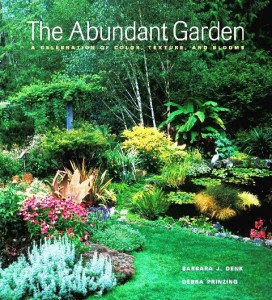 A version of this piece originally appeared in my 2005 book, The Abundant Garden (Cool Springs Press), photographed by Barbara J. Denk, a gifted Bainbridge Island-based photographer.
A version of this piece originally appeared in my 2005 book, The Abundant Garden (Cool Springs Press), photographed by Barbara J. Denk, a gifted Bainbridge Island-based photographer.
I recently updated the text as an article that appears in the current Southern California Horticultural Society newsletter.
RHYTHM AND MOTION
In landscape design, you can create a visual flow through the garden with the dynamic element of rhythm.
As a beat is to music, as choreographed steps are to a dance, rhythm animates a garden. Even if the wind doesn’t blow, your garden can look and feel infused with energy.
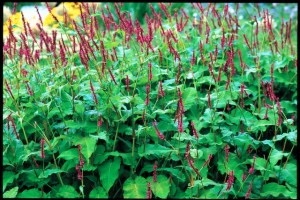
Raspberry-red spikes of aptly named Persicaria amplexicaulis 'Firetail' erupt in this singular performance of color and form. (Barbara J. Denk photograph)
MOTION: We experience a physical sensation when something rustles or sways in the garden. We pause to appreciate movements, subtle or dramatic – flowing water, rippling leaves, a billowing banner, or clanging chimes – because they signal life’s evanescent qualities. Such movements resonate as the garden responds to the earth’s vital elements.
By the very act of creating a garden, we embrace the external forces of nature, most of which are out of our control. In addition to rays of sunlight and rain showers, the kinetic presence of wind and breeze in our landscapes is important to channel – as movement – in a planting scheme.
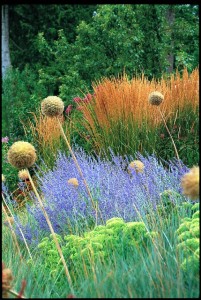
The ball-shaped seed heads of Allium 'Globemaster' are showcased against a rhythmic display of Calamagrostis x acutiflora 'Karl Foerster', velvety Russian sage (Perovskia atriplicifolia) and Sedum 'Autumn Joy' (Barbara J. Denk photograph)
It’s rewarding to see how climatic changes affect the garden, something we can’t help but notice, whether there are extreme gusts or light flurries flowing through branches and stems. When we intentionally design the garden to capture these movements, we infuse an otherwise commonplace landscape with vitality.
The choices of plants that can catch the airflow, gently dance, or furiously shake are endless. Perennials with tall, slender stems ripple like the fringe on a canopy (think of a vibrant stand of daylilies or a swath of lavender).
Fluffy inflorescences of maiden grass undulate above its finely-textured blades – and the overall effect is a seductive rhythm. The leaves of a California pepper tree shimmer like sequins on an evening gown. Agapanthus seedpods rattle and whisper as autumn arrives. The natural symphony energizes any landscape.
RHYTHM: Beyond individual plants, the visual suggestion of animation or motion can also be incorporated into the overall template of a garden. The repetition of organic forms, the course of a sinuous path, or the sensual outlines of beds and borders suggest movement. Alternating shapes – the gradual widening or narrowing of a space, the regular spacing of trees – do as well.
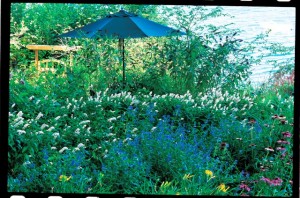
Calm white and intense blue join for a duet of gentle movement. A border of creamy white Lysimachia clethroides relates well with a stand of blue-flowering Caryopteris x clandonensis (Barbara J. Denk photograph)
When the tiny stones in a Zen garden are raked into concentric circles, movement appears. When a “stream” of large, smooth, river rocks fills a gully or trench, the sense of running water is implied. The sequence of stepping stones spaced through a cushioned ground cover of fragrant thyme invigorates the scene and helps direct the viewer’s eye through the garden. The scene is emotionally alive and visually pleasing.
Movement in a garden is essential. It’s the organic rhythm, the fluid characteristic that every garden needs in order to come to life for those who enjoy it.
Here are some tips for “animating” your garden:
- Develop a repertoire of plants:
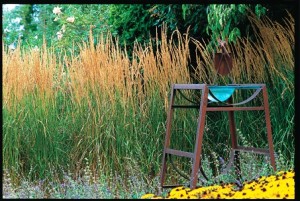
A glass bowl - a modern birdbath - is showcased against a coppery stand of Karl Foerster grass - an exquisite choice for "motion" in the garden (Barbara J. Denk photograph)
Base your plant selection on the scale of your house and the natural setting around it. Once you’ve selected the primary plants – those that provide structure and have multiseason interest, such as ornamental grasses – you can choose a second wave of plants to “star” in specific seasons.
- Create a basic framework for design:
Choose a template and follow it consistently throughout the garden. One method is to mirror dominant lines of your house, such as repeating key architectural shapes in the landscape. Use these as a guide for shaping pathways and planting beds. For example, a home’s arched windows and doorways might be echoed in the contour of a border or patio. Alternately, you can borrow a framework for design from nature, such as the irregular rhythm of distant hills.
- Consider the vertical dimension:
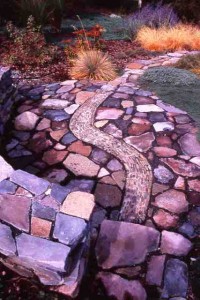
Hardscape, such as this fabulous pebble "river" running through a flagstone patio, can animate and energize the landscape. This was designed and installed by my Yakima friends Linda Knutson and Ron Sell (Debra Prinzing photograph)
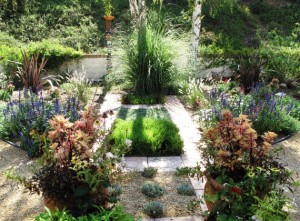
Backlighting is magical, even in my own backyard. I love the morning sun as it illuminates and highlights the various blades, stems and leaves (Debra Prinzing photo).
Select plants that bring height, energy, and motion into the garden, and vary their placement for impact.
Even if surrounded by buildings on every side, your garden will respond to daily and seasonal climate changes. Watch how breezes move through the garden, and capture that energy by placing fluid plants where currents flow. Notice where the sun rises and sets in relation to your landscape, and choose trees, shrubs, grasses, and other perennials that will reflect the morning light or absorb sunset’s glow. Red and purple foliage turns flame-like when backlit. As the sun’s rays shine through fringed tassels of fountain grass or pampas grass, the garden will shimmer in response.








